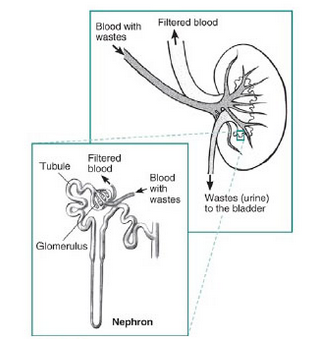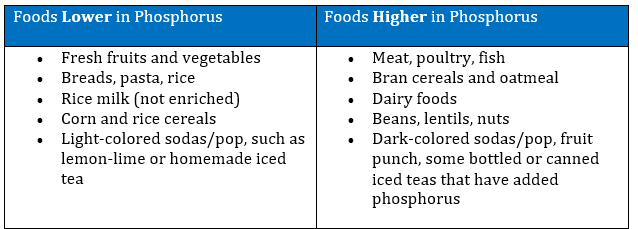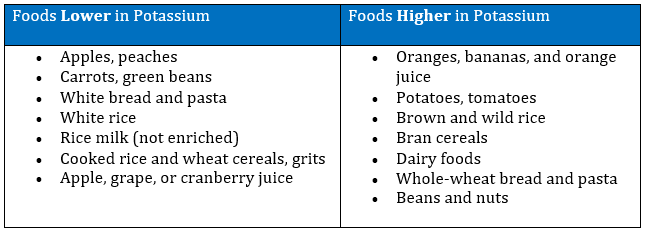Chronic kidney disease
What is Chronic Kidney Disease?
Chronic kidney disease (CKD), also known as chronic renal disease, is a condition that occurs when your kidneys cannot filter waste, toxins, and excess fluid from your blood and maintain a healthy balance in your body. The disease is called “chronic” because the damage to your kidneys happens slowly over a long period of time.
Kidney disease results from damage to the nephrons, which are the tiny structures inside your kidneys that filter blood. If the kidneys are not working properly, waste build up in the bloodstream, causing dysfunction in the body, and ultimately becomes life threatening.
Symptoms of Chronic Kidney Disease
Early on in kidney disease, you may have no symptoms at all. That is why it is so important that you see your primary care physician, ask to be screened for kidney disease, and find out what your risk factors are.
As kidney disease gets worse, a person may have some or all of the following symptoms:
- Fatigue – feeling excessively tired and have less energy
- Swelling, called Edema, due to excess fluid in the legs, feet, or ankles
- Puffiness around eyes, especially in the morning
- Bubbly or foamy urine indicating protein leakage
- Urine that is red, bright pink, or tea colored
- Urinating more or less often than normal
- A marked decrease in the amount of urine
- Mild back pain below the ribs and above the pelvis
- Insomnia or having trouble sleeping
- Less appetite than usual
- Trouble concentrating
- Muscle cramping at night
- Dry, itching skins, called Pruritus, due to high level of Phosphorous
- Nausea and vomiting
- Bad taste in mouth
- Unexpected weight loss
- Chest pain or shortness of breath
- Urinary Tract Infection
Causes and Risk Factors of Chronic Kidney Disease
Diabetes
Diabetes is the number one cause of Chronic Kidney Disease (CKD). Too much glucose, also called sugar, in your blood damages your kidneys’ filters. Over time, your kidneys can become so damaged that they no longer do a good job filtering wastes and extra fluid from your blood.
Often, the first sign of kidney disease from diabetes is protein in your urine. When the filters are damaged, a protein called albumin which you need to stay healthy, passes out of your blood and into your urine. A healthy kidney doesn’t let albumin pass from the blood into the urine.
Diabetic kidney disease is the medical term for kidney disease caused by diabetes.
High Blood Pressure (Hypertension)
High blood pressure is the second leading cause of Chronic Kidney Disease (CKD). High blood pressure can damage blood vessels in the kidneys so they don’t work as well. If the blood vessels in your kidneys are damaged, your kidneys may not function properly to remove wastes and extra fluid from your body. Extra fluid in the blood vessels may then raise blood pressure even more, creating a dangerous cycle.
Glomerular Diseases
Glomerular diseases damage glomeruli and is the third leading cause of kidney disease. The glomeruli are sets of looping blood vessels in nephrons—the tiny working units of the kidneys that filter wastes and remove extra fluid from the blood.

Glomerular diseases cause protein and sometimes red blood cells leak into the urine. Sometimes a glomerular disease also interferes with the clearance of waste products by the kidney, so they begin to build up in the blood. Furthermore, loss of blood proteins like albumin in the urine can result in a fall in their level in the bloodstream.
Family History of Kidney Failure
You are at higher risk for Chronic Kidney Disease (CKD) if your mother, father, sister, or brother has kidney failure. In general, kidney disease tends to run in families. If you or close family members have kidney disease, encourage family members to get tested.
Other Causes of Kidney Disease
Other causes of kidney disease include:
- A genetic disorder that causes many cysts to grow in the kidneys called Polycystic Kidney Disease (PKD)
- Urinary and other infections
- Drug that is toxic to the kidneys
- A disease that affects the entire body, such as Lupus
- Alport Syndrome, disorders in which the body’s immune system attacks its own cells and organs
- Heavy metal poisoning, such as lead poisoning
- Renal artery stenosis (RAS) is the narrowing of one or both renal arteries
- Obstructions caused by problems like kidney stones, tumors or an enlarged prostate gland in men
Tests and Diagnosis for Chronic Kidney Disease (CKD)
Early kidney diseases may not show any symptoms, or you may see some symptoms. In any case, testing is the only way to know how well your kidneys are working.
Get checked for kidney disease as part of regular, periodic health checkups or if you have
- Any symptoms described above
- Diabetes
- High Blood Pressure
- Heart Disease
- A family history of kidney failure
To check for kidney disease, health care providers use
- A blood test that checks how well your kidneys are filtering your blood, called GFR. GFR stands for Glomerular Filtration Rate. Providers use the amount of Creatinine in your blood to estimate your GFR. Creatinine is a waste product from the normal breakdown of muscles in your body. Your kidneys remove Creatinine from your blood. As kidney disease gets worse, the level of Creatinine goes up in your blood.
- A urine test to check Albumin. Albumin is a good protein that should not be in urine. But a damage kidney can pass Albumin into the urine. As kidney disease gets worse, the level of Albumin goes up in your urine. A urine Albumin result of 30 mg/g or less is normal. More than 30 mg/g may be a sign of kidney disease.
If you have kidney disease, your health care provider will use the same two tests to help monitor your kidney disease and make sure your treatment plan is working.
Additionally, if the test results show that you have kidney disease, the doctor will want to pinpoint your diagnosis and check your kidney function to help plan your treatment. The doctor may do the following:
- Perform an ultrasound or CT scan to get a picture of your kidneys and urinary tract. This tells your doctor whether your kidneys are too large or too small, whether you have a problem like a kidney stone or tumor and whether there are any problems in the structure of your kidneys and urinary tract.
- Perform a kidney biopsy, which is done in some cases to check for a specific type of kidney disease, see how much kidney damage has occurred and help plan treatment. To do a biopsy, the doctor removes small pieces of kidney tissue and looks at them under a microscope.
You can’t raise your GFR, but you can try to keep it from going lower.
Stages of Kidney Disease
Your Glomerular Filtration Rate (GFR) determines the stage of kidney disease.
GFR is expressed in mL/min/1.73m2.
Normal value is considered to be above 90 mL/min/1.73m2.

Free Online Self-Test from the National Kidney Foundation in the United States of America (USA)
You can do a free online self-test to find individualized information about your kidney and overall health from the National Kidney Foundation in the United States of America (USA). It is a very quick, easy, and free service to find out if you have the risk of developing Chronic Kidney Disease (CKD).
Free self-test link to the National Kidney Foundation in the USA
Typically there is no symptom of kidney disease at early stages. So the best and only method to know your kidneys are healthy is to do a blood test for GFR (Glomerular Filtration Rate) and a urine test for Albumin described in section 2.3 of this guidebook.
The sooner you know, the better.
Preventing Chronic Kidney Disease (CKD)
You can protect your kidneys by preventing or managing health conditions that cause kidney damage, such as diabetes and high blood pressure. The steps described below may help keep your whole body healthy, including your kidneys.
Ten Ways to Prevent Kidney Disease
- Make healthy food choices
- Make physical activity part of your routine
- Aim for healthy weight
- Get enough sleep
- Stop smoking
- Stop alcohol consumption
- Explore stress reducing activities
- Manage Diabetes
- Manage High Blood Pressure
- Manage Heart Disease
Managing Chronic Kidney Disease (CKD)
If you have chronic kidney disease (CKD), you can take steps to protect your kidneys from more damage. The focus is to stop the progression of kidney disease so that your Chronic Kidney Disease (CKD) does not become End Stage Kidney Disease (ESKD) – also called End Stage Renal Disease (ESRD) – that require transplant or dialysis.
The sooner you know you have kidney disease, the better. The steps you take to protect your kidneys from damage also may help prevent heart disease—and improve your health overall. Making these changes when you have no symptoms may be hard, but it’s worthwhile.
Ten Ways to Manage Kidney Disease
- Eating right for Chronic Kidney Disease – develop a kidney friendly meal plan
- Control your blood pressure
- Meet your blood glucose goal if you have diabetes
- Work with your health care team to monitor your kidney health
- Take medicines as prescribed by your Nephrologists
- Make physical activity part of your routine
- Aim for a healthy weight
- Get enough sleep
- Stop smoking
- Find healthy ways to cope with stress and depression
Eating right for Chronic Kidney Disease
You may need to change what you eat to manage your chronic kidney disease (CKD). Work with your Nephrologist or a registered dietitian to develop a meal plan that includes foods that you enjoy eating while maintaining your kidney health.
The steps below will help you eat right as you manage your kidney disease. The first three steps (1-3) are important for all people with kidney disease. The last two steps (4-5) may become important as your kidney function goes down.
Step 1: Choose and prepare foods with less salt and sodium
Why? To help control your blood pressure. Your diet should contain 2,000 to 2,200 milligrams (mg) of Sodium each day.
- Buy fresh food often. Sodium (a part of salt) is added to many prepared or packaged foods you buy at the supermarket or at restaurants.
- Cook foods from scratch instead of eating prepared foods, “fast” foods, frozen dinners, and canned foods that are higher in sodium. When you prepare your own food, you control what goes into it.
- Use spices, herbs, and sodium-free seasonings in place of salt.
- Check for Sodium on the Nutrition Facts label of food packages. A Daily Value of 20 percent or more means the food is high in sodium.
- Try lower-Sodium versions of frozen dinners and other convenience foods.
- Rinse canned vegetables, beans, meats, and fish with water before eating.
Look for food labels with words like Sodium free or salt free; or low, reduced, or no salt or sodium; or unsalted or lightly salted.
Step 2: Eat the right amount and the right types of protein
Why? To help protect your kidneys. When your body uses protein, it produces waste. Your kidneys remove this waste. Eating more protein than you need may make your kidneys work harder. A low-protein diet (LPD) of 0.6-0.8 g/kg per day is often recommended for the management of CKD.
- Eat small portions of protein foods.
- Protein is found in foods from plants and animals. Most people eat both types of protein. Talk to your dietitian about how to choose the right combination of protein foods for you.
Animal-protein foods:
- Chicken
- Fish
- Meat
- Eggs
- Dairy
A cooked portion of chicken, fish, or meat is about 2 to 3 ounces or about the size of a deck of cards. A portion of dairy foods is ½ cup of milk or yogurt, or one slice of cheese.
Plant-protein foods:
- Beans
- Nuts
- Grains
A portion of cooked beans is about ½ cup, and a portion of nuts is ¼ cup. A portion of bread is a single slice, and a portion of cooked rice or cooked noodles is ½ cup.
Step 3: Choose foods that are healthy for your heart
Why? To help keep fat from building up in your blood vessels, heart, and kidneys.
- Grill, broil, bake, roast, or stir-fry foods, instead of deep frying.
- Cook with nonstick cooking spray or a small amount of olive oil instead of butter.
- Trim fat from meat and remove skin from poultry before eating.
- Try to limit saturated and trans fats. Read the food label.
Heart-healthy foods:
- Lean cuts of meat, such as loin or round
- Poultry without the skin
- Fish
- Beans
- Vegetables
- Fruits
- Low-fat or fat-free milk, yogurt, and cheese
Stop alcohol consumption.
The Next Steps to Eating Right
As your kidney function goes down, you may need to eat foods with less Phosphorous and Potassium. Your health care provider will use lab tests to check Phosphorus and Potassium levels in your blood, and you can work with your dietitian to adjust your meal plan.
Step 4: Choose foods and drinks with less Phosphorus
Why? To help protect your bones and blood vessels. When you have CKD, phosphorus can build up in your blood. Too much Phosphorus in your blood pulls Calcium from your bones, making your bones thin, weak, and more likely to break. High levels of phosphorus in your blood can also cause itchy skin, and bone and joint pain.
- Many packaged foods have added Phosphorus. Look for Phosphorus—or for words with “PHOS”—on ingredient labels.
- Deli meats and some fresh meat and poultry can have added Phosphorus. Ask the butcher to help you pick fresh meats without added phosphorus.

A kidney friendly diet usually involves limiting Phosphorous between 800 to 1,000 milligrams (mg) per day. Your Nephrologist may talk to you about taking a Phosphate Binder with meals to lower the amount of Phosphorus in your blood. A Phosphate Binder is a medicine that acts like a sponge to soak up, or bind, Phosphorus while it is in the stomach. Because it is bound, the Phosphorus does not get into your blood. Instead, your body removes the phosphorus through your stool.
Step 5: Choose foods with the right amount of Potassium
Why? To help your nerves and muscles work the right way. Problems can occur when blood Potassium levels are too high or too low. Damaged kidneys allow Potassium to build up in your blood, which can cause serious heart problems. Your food and drink choices can help you lower your Potassium level, if needed. A kidney friendly diet usually involves limiting Potassium intake to 2,000 milligrams (mg) per day
- Salt substitutes can be very high in Potassium. Read the ingredient label. Check with your provider about using salt substitutes.
- Drain canned fruits and vegetables before eating.

Some medicines also can raise your Potassium level. Your Nephrologist may adjust the medicines you take.
